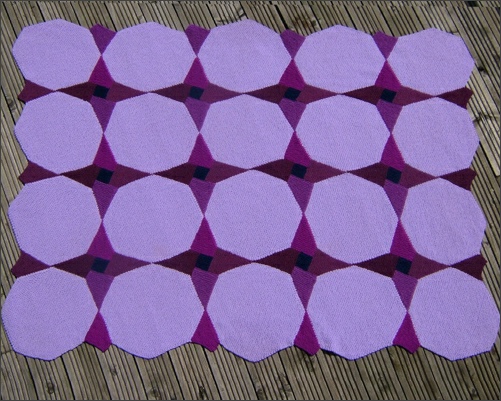




What other shapes could we make within our self-
Beginning with one of the sides of an octagon the first two sides turn out from that side at 135 degrees, the next two sides require straight knitting and the next two turn in by 45 degrees. The eighth side is the casting off edge.
When we had made hats many years before, we had calculated an easy way to knit an octagon, based on knowing the length of one side, You might expect a hat to be round but, technically, it is not possible to knit a perfect circle. The nearest approximation is a polygon with many sides. Because knitting is easily stretched and deformed, an octagon can easily take on the form of a circle. Pieces of Eight was made from similar octagons but these were not allowed to deform.
When octagons are fitted together, with their sides touching, the spaces left in
between are squares. When they touch at points the spaces are stars. It would be
extremely difficult to make those stars according to our rules but splitting the
star shape into five pieces meant that a centre square could be worked first and
four right-
Pieces of Eight was not intended to depict an optical illusion.What you see on paper, or a computer screen, is not necessarily what you see when it is reproduced at a larger scale. Pieces of Eight prompted arguments we had not expected. To us, it was a tessellation of stars and octagons. It completely covered the area, as a tessellation should. Very few pupils saw it that way until it was pointed out to them. This inevitably produced oohs, ahs and grins and an end to the arguments that had arisen from the different ways they saw it. Some had seen octagons with holes in between, others had seen only stars and did not recognise that a regular octagon filled the space between them. This may have been the result of the colours we had chosen. If the ‘background’ and ‘foreground’ colours had been of equal intensity so that they vied with each other for importance perhaps they would not have had such a ‘black and white’ view. This lead to us looking at more optical illusions.
We all think that what we see is the same as what everyone else sees. This was obviously
not true. As teachers, this taught us another lesson -
